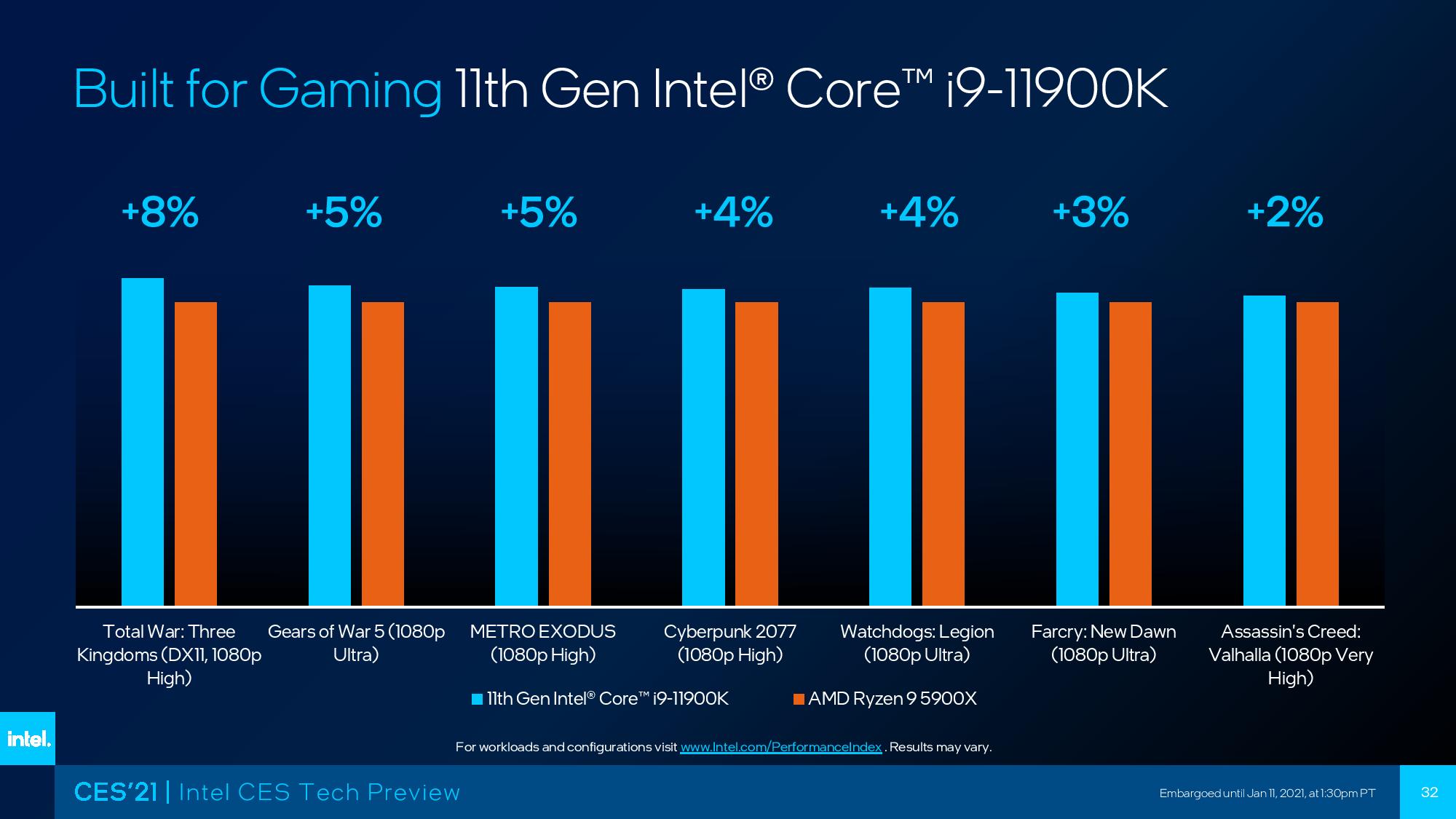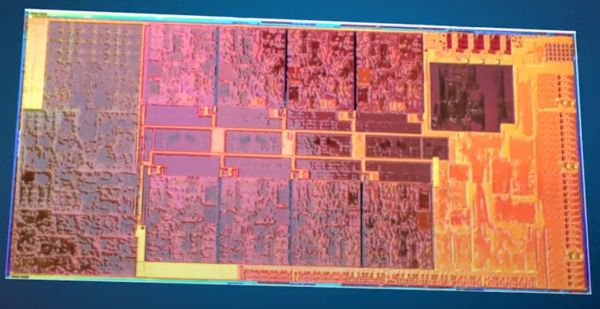Intel Rocket Lake Price, Benchmarks, Specs and Release Date, All We Know
Blasting off

Intel's 11th-Gen Rocket Lake is purportedly headed to the launch pad for blast off on March 30, promising to upset our list of Best CPUs for Gaming and CPU Benchmarks Hierarchy. Rocket Lake certainly couldn't come at a better time for Intel, either – AMD's Ryzen 5000 processors have thundered into the desktop PC market, upsetting Intel's Comet Lake chips and taking the lead in every metric that matters, including gaming.
Intel's response comes in the form of Rocket Lake, and the company says the chips come with a 19% improvement in instruction per cycle (IPC) throughput and blistering 5.3 GHz (+) clock speeds that will reestablish its performance leadership in gaming.
Rocket Lake will bring the backported Cypress Cove architecture to the desktop PC, Intel's first new microarchitecture in six years. But unlike the forward progress we see with the company's 10nm Tiger Lake chips for laptops, Rocket Lake-S represents 14nm's last hurrah on the desktop and marks the seventh and final iteration of the longest-lived leading-edge node in Intel's history (it debuted in 2015).
Intel's current integrated graphics are woefully inadequate for gaming, and we haven't seen a meaningful iGPU performance boost for desktop PCs since Kaby Lake arrived back in 2016. This changes with Rocket Lake, which comes with Intel's performant 12th-gen Xe graphics. Intel says the new engine doubles graphics performance over the previous-gen chips, bringing 1080p-capable gaming (albeit with low fidelity settings) to mainstream CPUs. We do know that Intel has also plumbed in support for Resizable BAR, which boosts performance with discreet GPUs.
Rocket Lake supports the PCIe 4.0 interface, which provides twice the bandwidth of PCIe 3.0. That addresses a key weakness exacerbated by AMD's now two-year-long advantage with its uncontested leadership position in I/O connectivity. Intel has also bumped up Rocket Lake's memory throughput to DDR4-3200, a nice step up from the prior gen's DDR4-2933.
So what's the catch? Rocket Lake tops out at eight cores and sixteen threads due to the backported architecture, a step back from the 10-core Comet Lake i9 models. "Backporting" is a method that allows Intel to take a new design built on a smaller process node, in this case 10nm, and etch it on an older, larger node (in this case, 14nm).
Intel backported the 10nm Sunny Cove cores found in Ice Lake processors to the less-dense 14nm process to create Rocket Lake's Cypress Cove architecture, leaving the chip designers with fewer transistors to make the new chips. As a result, Intel had to remove two cores; there simply wasn't enough room in the chip package for a larger die. Intel says it backported its Sunny Cove design from the 10nm process to its aging 14nm to create the new design, a necessity because 10nm couldn't support the higher frequencies needed for desktop PCs (we imagine yields might have played a role, too).
That's an odd development in light of Intel's 10-core Comet Lake flagships, not to mention that eight cores certainly feels inadequate in the face of AMD's 16-core Ryzen 9 5950X. Intel admits that Rocket Lake's lowered core count can lead to reduced gen-on-gen performance in heavily-threaded applications, but the company is betting heavily on its 19% IPC gains and high clock speeds to offset the lower core counts. The Alder Lake hybrid chips will come in later to address the higher core count segment.
Rocket Lake slots into Intel's 11th-gen processor family, but Intel is using refreshed Comet Lake chips for Core i3 (and lower) 11th-gen processors, which is another interesting development. Intel has slowly teased out the details of the Rocket Lake chips, but recently divulged the full details ahead of the review embargo lift later this month. Let's cover what we know so far.
Intel 11th-Gen Rocket Lake At a Glance
- Maximum of eight cores, 5.3 GHz peak boost speed
- New Cypress Cove architecture featuring Ice Lake Core architecture and Tiger Lake Graphics architecture.
- Support for PCIe 4.0 - 20 lanes (four to storage)
- New microarchitecture for the desktop
- AVX-512, Thunderbolt 4 support
- Intel plans to launch Rocket Lake on March 30, 2021
- Intel 12th-gen Xe LP Graphics increase graphics performance by 50%
- Support for DDR4-3200 for Rocket Lake, DDR4-2666 for Comet Lake Refresh
- New overclocking features for more flexible tuning performance
- Intel Deep Learning Boost and VNNI support
- Backward compatible with 400-series motherboards (caveats apply)
Intel Rocket Lake Release Date and Availability
Intel has given an official March 30, 2020 release window for Rocket Lake-S processors, and pre-orders are live now. It appears that Intel has solid availability of the chips, they're widely available for pre-order at retail outlets, signalling the company isn't encountering the same shortages we see with the competing high-end Ryzen 5000 processors.
Intel also officially announced that its 10nm hybrid Alder Lake-S chips would launch in the second half of 2021. That timeline indicates that Rocket Lake will likely serve either as a short-lived stopgap or as part of a split product stack for the mainstream desktop, with the Alder Lake chips stepping in as the high core count flagships. The Alder Lake-S processors are thought to come with DDR5 and PCIe 5.0 support, marking a big step forward for the desktop PC.
Intel 11th-Gen Rocket Lake Pricing and Specifications
| Product Identifier | Suggested Price | Cores / Threads | Base (GHz) | Peak Boost (Dual/All Core) | TDP | iGPU | L3 |
| Ryzen 9 5950X | $799 | 16 / 32 | 3.4 | 4.9 | 105W | None | 64MB (2x32) |
| Ryzen 9 5900X | $549 | 12 / 24 | 3.7 | 4.8 | 105W | None | 64MB (2x32) |
| Ryzen 7 5800X | $449 | 8 / 16 | 3.8 | 4.7 | 105W | None | 32MB (1x32) |
| RKL-S Core i9-11900K (KF) | $539 (K) - $513 (KF) | 8 / 16 | 3.5 | 5.3 / 4.8 (TVB) | 125W | UHD Graphics 750 Xe 32EU | 16MB |
| CML-S Core i9-10900K (KF) | $488 (K) / $472 (KF) | 10 / 20 | 3.7 | 5.3 / 4.8 (TVB) | 125W | UHD Graphics 630 | 20MB |
| CML-S Core i9-10850K | $453 | 10 / 20 | 3.6 | 5.2 / 4.8 (TVB) | 125W | UHD Graphics 630 | 20MB |
| RKL-S Core i9-11900 (F) | $439 - $422 (F) | 8 / 16 | 2.5 | 5.2 (TVB) / 4.7 | 65W | UHD Graphics 750 Xe 32EU | 16MB |
| RKL-S Core i7-11700K (KF) | $399 (K) - $374 (KF) | 8 / 16 | 3.6 | 5.0 (TB3) / 4.6 | 125W | UHD Graphics 750 Xe 32EU | 16MB |
| CML-S Core i7-10700K (KF) | $374 (K) / $349 (KF) | 8 / 16 | 3.8 | 5.1 (TB3) / 4.7 | 125W | UHD Graphics 630 | 16 MB |
| RKL-S Core i7-11700 (F) | $323 -$298 (F) | 8 / 16 | 2.5 | 4.9 (TB3) / 4.4 | 65W | UHD Graphics 750 Xe 32EU | 16MB |
| Ryzen 5 5600X | $299 | 6 / 12 | 3.7 | 4.6 | 65W | None | 32MB (1x32) |
| RKL-S Core i5-11600K (KF) | $262 (K) - $237(KF) | 6 / 12 | 3.9 | 4.9 (TB2) / 4.6 | 125W | UHD Graphics 750 Xe 32EU | 12MB |
| CML-S Core i5-10600K (KF) | $262 (K) / $237 (KF) | 6 / 12 | 4.1 | 4.8 (TB2) / 4.5 | 125W | UHD Graphics 630 | 12MB |
| RKL-S Core i5-11400 (F) | $182 - $157 | 6 / 12 | 2.6 | 4.4 (TB2) / 4.2 | 65W | UHD Graphics 750 Xe 24EU | 12MB |
A flurry of leaked benchmarks have emerged from Asian regions, including full-on reviews of some Rocket Lake-S chips. However, while the specifications and pricing listed above are official, the leaked benchmarks are not. Most of the tests were conducted on Intel reference validation platforms (RVP), indicating the silicon was still under development. As per usual, it's best to wait until official reviews.
As we can see above, Intel spreads the Rocket Lake (RKL-S) chips into the familiar Core i9, i7, and i5 families, but there's a fly in the ointment: Intel has decided to use refreshed Comet Lake (CML-R) chips for its Core i3 and Pentium families. Those chips feature the same architecture as other Comet Lake chips but come with slightly increased clock speeds.
As before, Intel offers graphics-less F-series models across its Core i9, i7, i5, and i3 families. The F-series models come with the same clock speeds and other features as the fully-featured models.
The eight-core 16-thread flagship Core i9-11900K comes with a suggested $539 price tag, a $51 markup over the previous-gen ten-core 10900K, but you pay the premium for two fewer cores. The 11900K is also more expensive than the $449 Ryzen 9 5800X. Even more concerning, the ten-core Core i9-10850K, which has nearly identical performance to the 10900K, weighs in at a mere $453, opening up a much larger $86 gap. Intel's performance benchmarks, which we'll get to shortly, tout faster gen-on-gen gaming performance, but the value proposition looks dicey. Of course, our own benchmarks will tell the tale.
Two of the 11900K's cores boost to a peak of 5.3 GHz, and all cores can operate at 4.8 GHz simultaneously. These are Thermal Velocity Boost frequencies that only activate if the processor is under a certain temperature limit, but most motherboard makers ignore those limits. That means the chips will likely operate at these speeds regardless of chip temperature, at least on higher-end motherboards. Intel has listed a 150W PL1 power rating (at the base frequency) for the 11900K, a 25W increase over the 10900K, but it has an identical 250W PL2 (boost) rating.
Intel has confirmed the chips feature a 150W PL1 power rating (at the base frequency), a 25W increase over the 10900K, and an identical 250W PL2 (boost) rating. Intel has also bumped up Rocket Lake's memory throughput to DDR4-3200, a nice step up from the prior gen's DDR4-2933, but here's where things get tricky: The Core i9-11900K is the only Rocket Lake chip that supports DDR4-3200 memory in the optimal configuration at stock settings, which is called 'Gear 1.' This setting allows the memory controller and memory frequency to operate at the same speed (1:1), thus providing the lowest latency and best performance in lightly-threaded work, like gaming.
Get Tom's Hardware's best news and in-depth reviews, straight to your inbox.
All other Rocket Lake chips only officially support DDR4-3200 with the 'Gear 2" setting, which downshifts the memory controller so that it operates at half the frequency of the memory (0.5:1). This setting trades higher memory latency (i.e., reduced performance in single-threaded work) for improved bandwidth, which can benefit a narrow selection of multi-threaded workloads.
For all other SKUs, the official top speed for the Gear 1 setting is DDR4-2933, and running DDR4-3200 in lower-latency Gear 1 mode is considered overclocking, which voids your warranty. Intel isn't sharing latency information to detail the differences between the two modes and how that impacts performance, so we'll have to suss that out in our review.
The $399 Core i7-11700K slots into the huge pricing gap between the $299 Ryzen 5 5600X and $449 Ryzen 7 5800X. Core counts are no longer the delineating feature between the Core i9 and Core i7 families; instead, we're left with a few bins of frequency and the differences in Gear modes. Like the 11900K, the 11700K chip comes with eight cores and 16 threads, but it doesn't have the Thermal Velocity Boost tech. As such, the 11700K tops out 5 GHz on two cores via Turbo Boost 3, while all-core frequency stretched up to 4.6 GHz.
The gen-on-gen price increase for the 11700K is lower, but still present. At $399, Intel commands a $25 premium over the previous-gen 10700K that comes with the same number of cores and slightly higher boost frequencies.
Intel's non-K Core i9 and i7 models carry the same pricing as their prior-gen counterparts, and pricing is also normalized with the $262 six-core Core i5-11600K, which matches the pricing of the previous-gen i5-10600K. This chip boosts to a peak of 4.9 GHz on two cores and can maintain a 4.6 GHz all-core frequency. The Core i5-11600K is a key model for Intel, as it contends directly with the $299 Ryzen 5 5600X in the heart of the mainstream gaming market.
The Core i5-11400 also stands out as a potentially great deal, with $182 (or $157 for the F-series part) being a solid price for a six-core 12-thread processor.
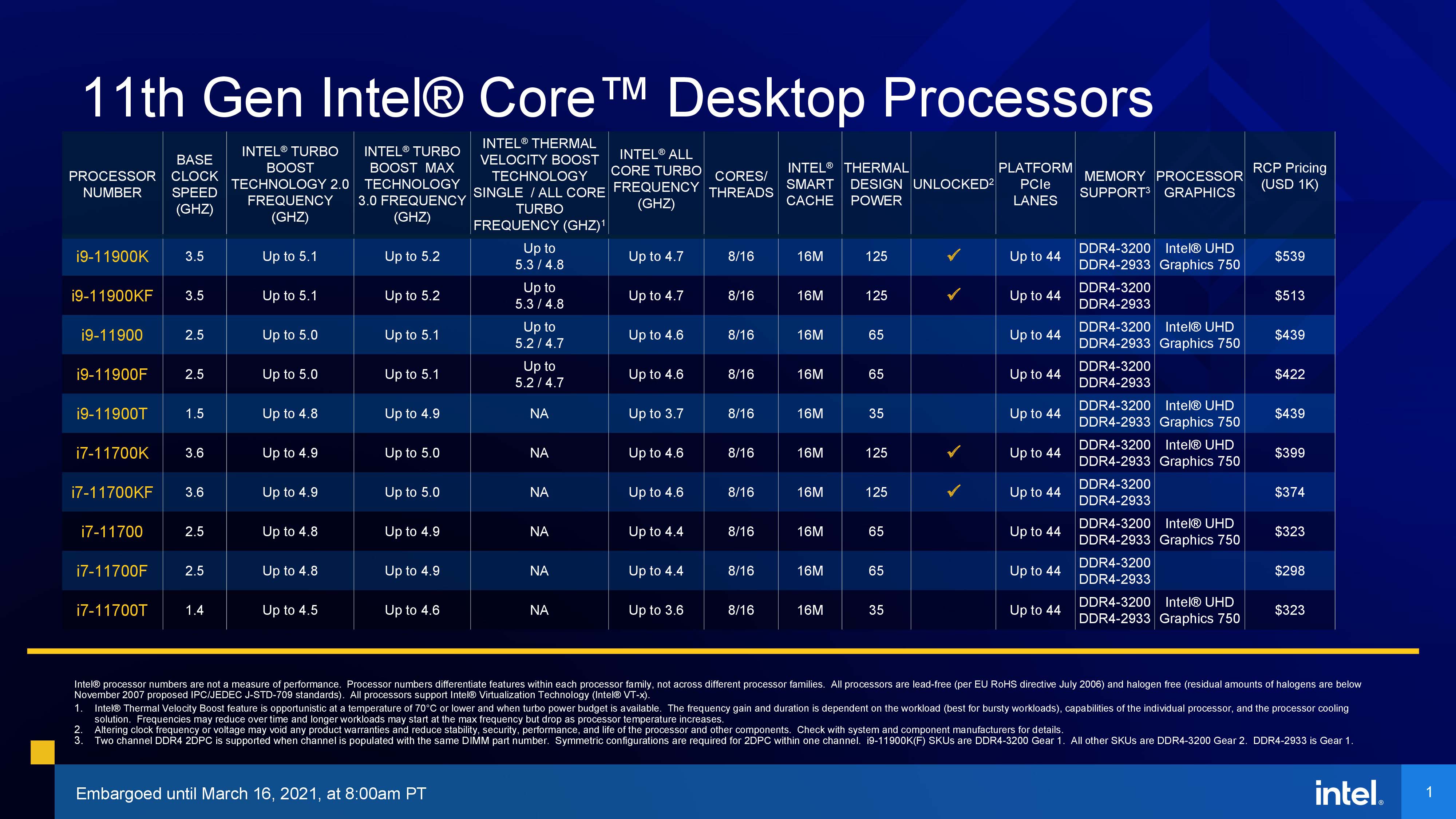
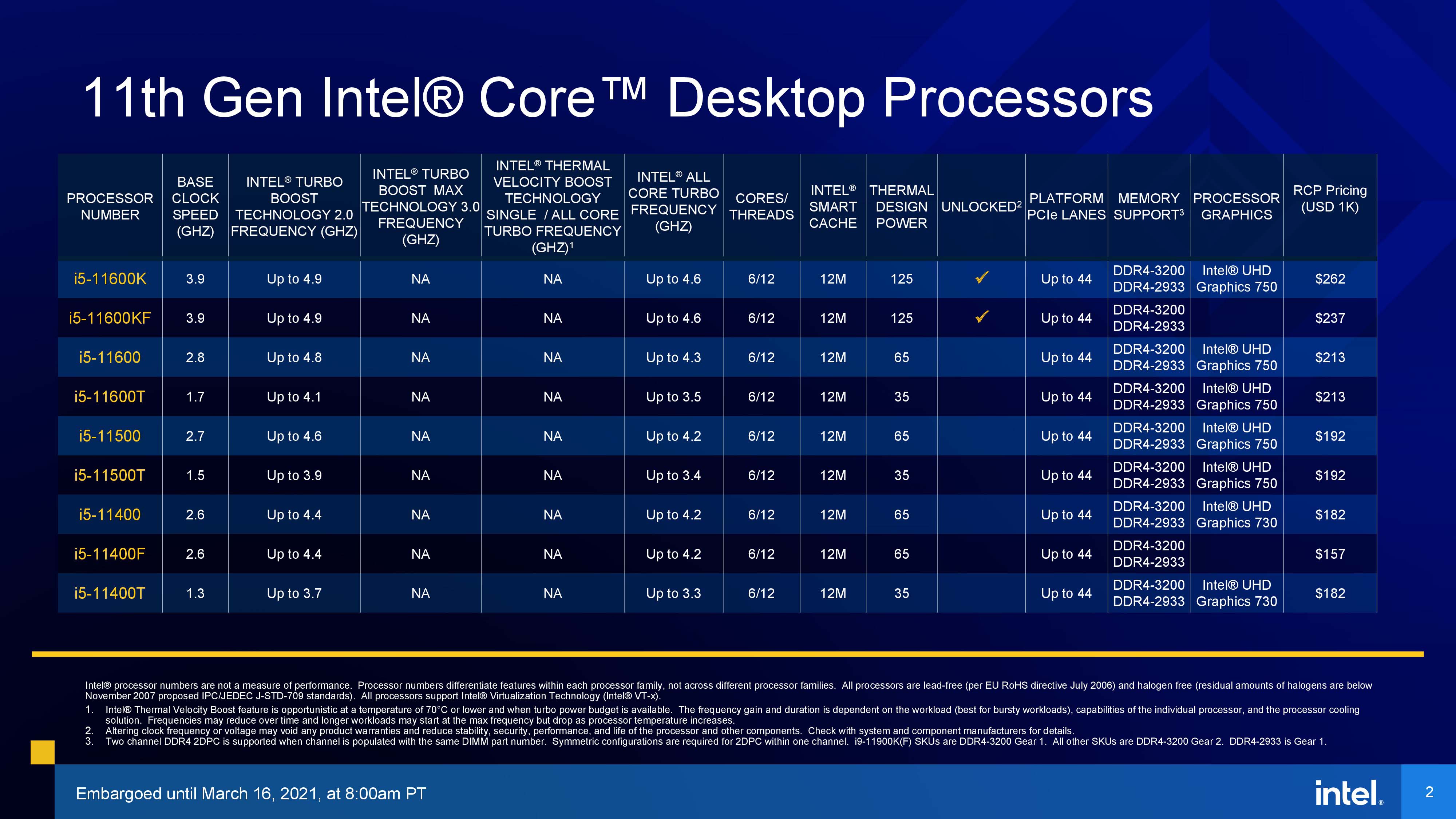
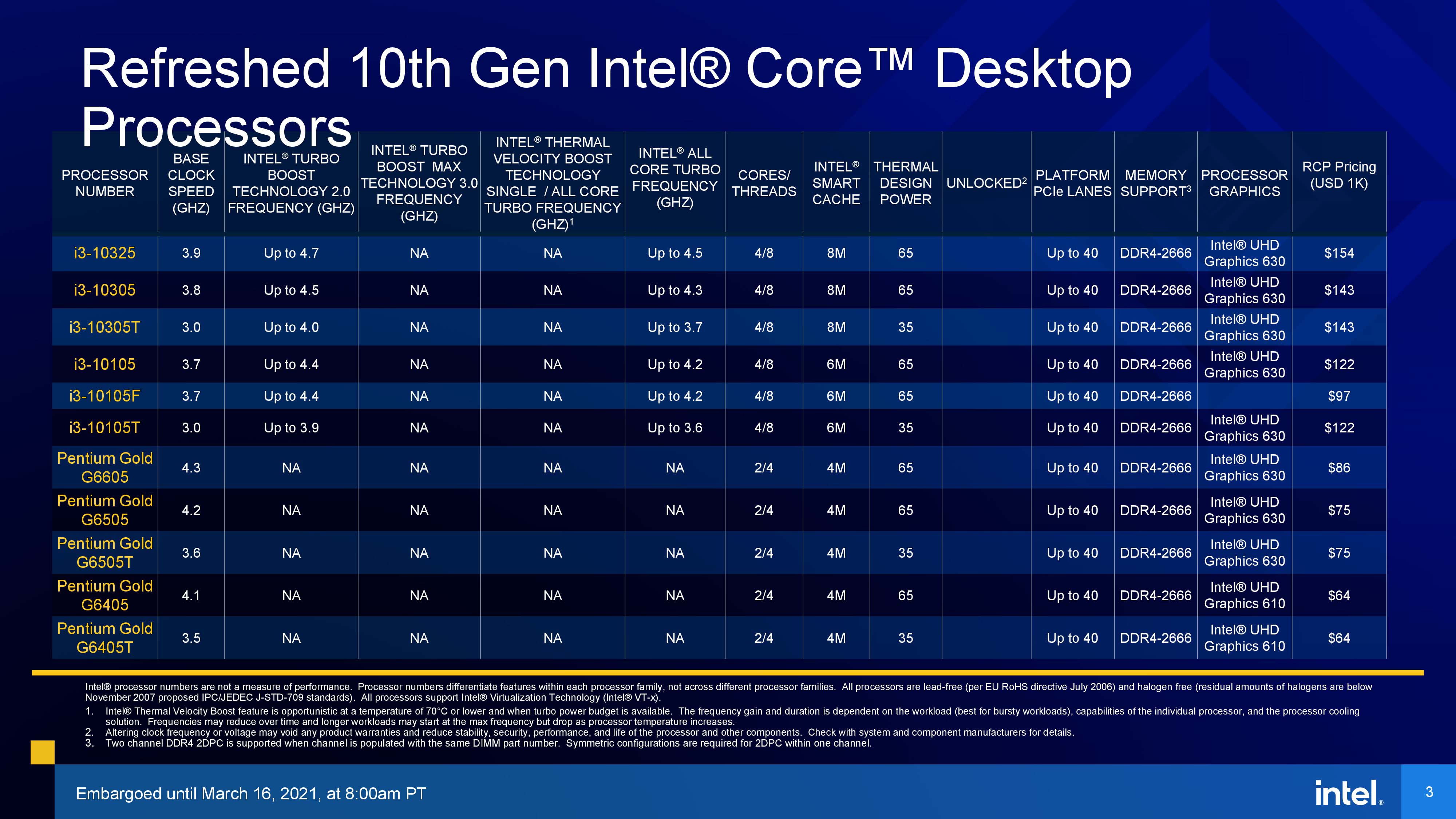
Here's the full list of both the Rocket Lake and Comet Lake Refresh SKUs. Intel's Comet Lake Refresh, which is comprised of models with slightly faster clock speeds than their predecessors, slot in for the Core i3 and Pentium families. These chips come with the same pricing as their predecessors, along with the same Comet Lake architecture and UHD Graphics 630 engine. Given the slight performance improvements, which are on the order of 100MHz for any given SKU, these chips are largely unimpressive.
Here's a guide to the different boost technologies that come with the Rocket Lake processors:
- Turbo Boost 2.0: Increased frequency if chip operates below power, current, and temperature specifications.
- Turbo Boost Max 3.0: Fastest cores are identified during binning, then the Windows scheduler targets the fastest two active cores (favored cores) with lightly-threaded applications. Chip must be below power, current, and temperature specifications.
- Single-Core Thermal Velocity Boost: Fastest active favored core can boost higher than Turbo Boost Max 3.0 if below a pre-defined temperature threshold (70C) and all other factors adhere to TB 3.0 conditions.
- All-Core Thermal Velocity Boost: Increases all-core frequency when all cores are active and the chip is under 70C.
Intel 11th-Gen Rocket Lake Gaming Benchmarks
Intel has slowly teased bits of info about Rocket Lake, but here's probably the most important new detail: Intel shared benchmarks that say the 8C/16T Core i9-11900K reclaims the gaming performance crown from AMD's Ryzen 9 5900X at 1080p. As always, we should approach vendor-provided benchmarks with caution.
Intel's wins are slim, though. Intel ran these tests with an EVGA RTX 3080 XC3 graphics card, and the company's claimed lead ranges from 2% to 8% (roughly a 4% advantage overall). That paints a picture of a closely-contested battle in gaming performance between Rocket Lake and Zen 3, particularly at higher resolutions.
Intel's traditionally higher overclocking ceilings could prove to be an advantage against the Ryzen 5000 processors — it's important to remember that Intel tested the Rocket Lake chip at stock settings. If these slim deltas play out in our testing and the Intel chips overclock well, pricing might be the determining factor if you're on the hunt for a gaming processor in 2021.
We've also seen benchmark submissions from a Rocket Lake chip overclocked to 6.9 GHz on liquid nitrogen, along with a string of benchmarks conducted on engineering samples, but we should keep in mind that these are pre-production chips and might not fully encapsulate the performance we'll see when the chips come to retail.

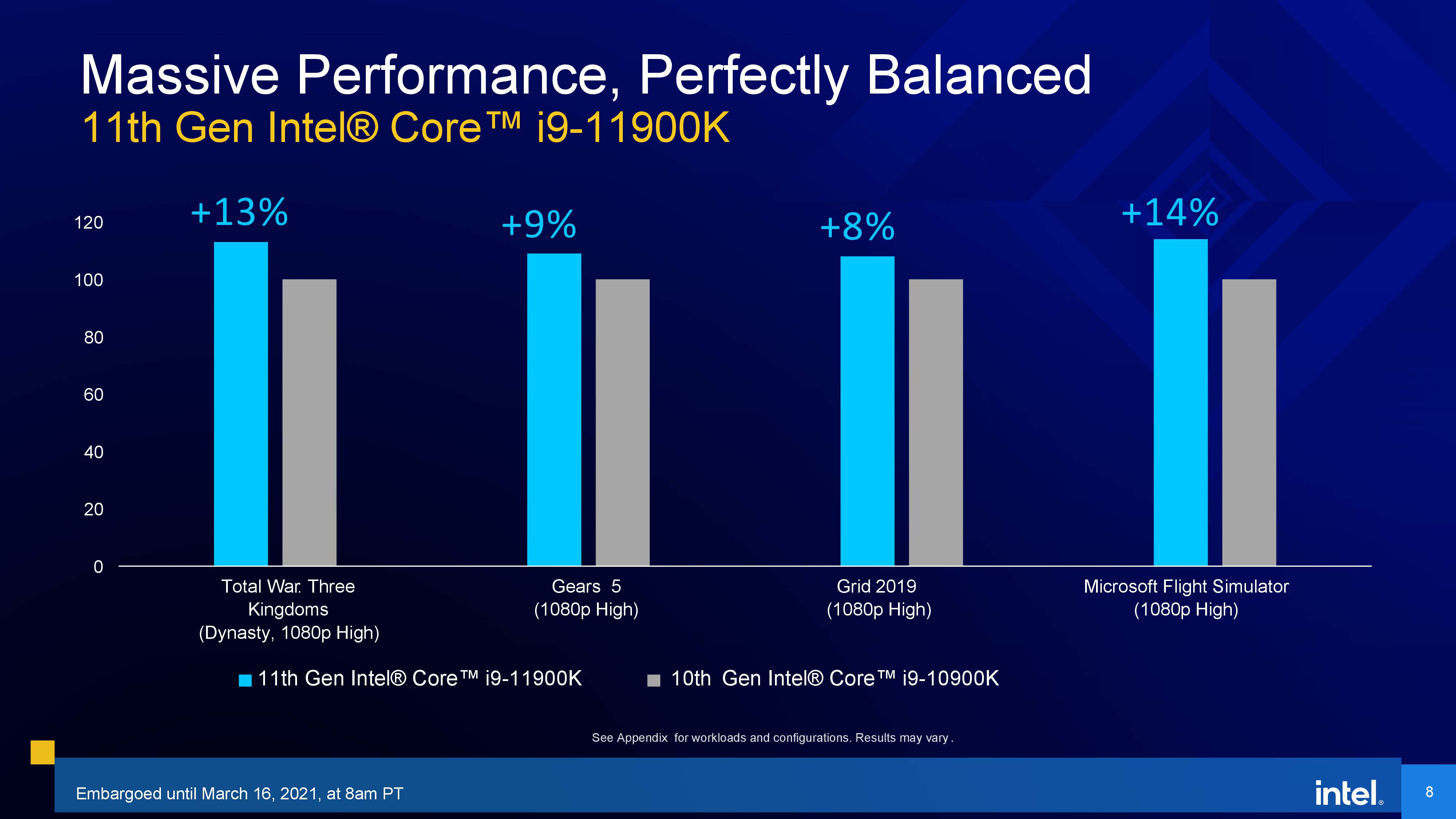
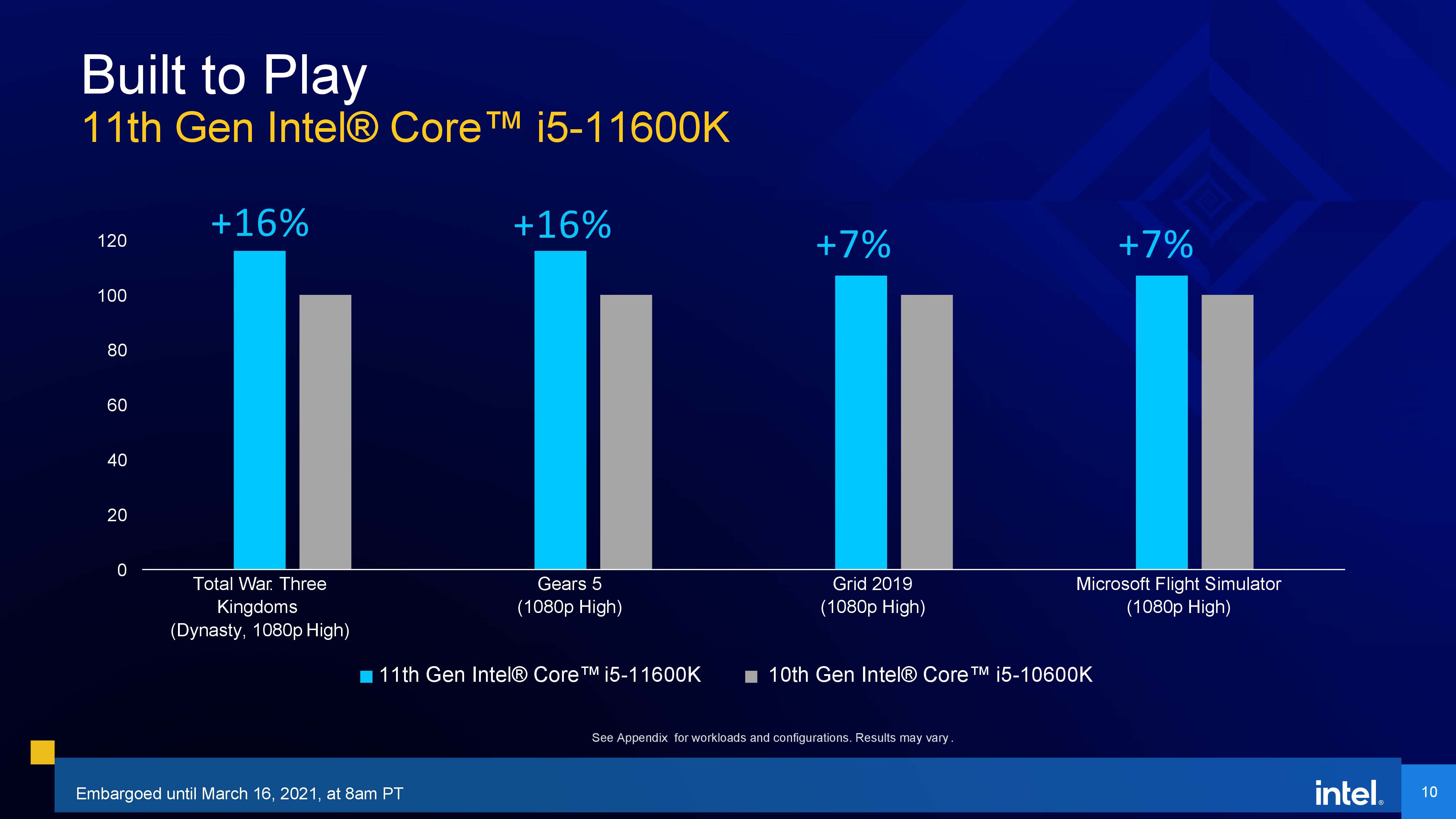
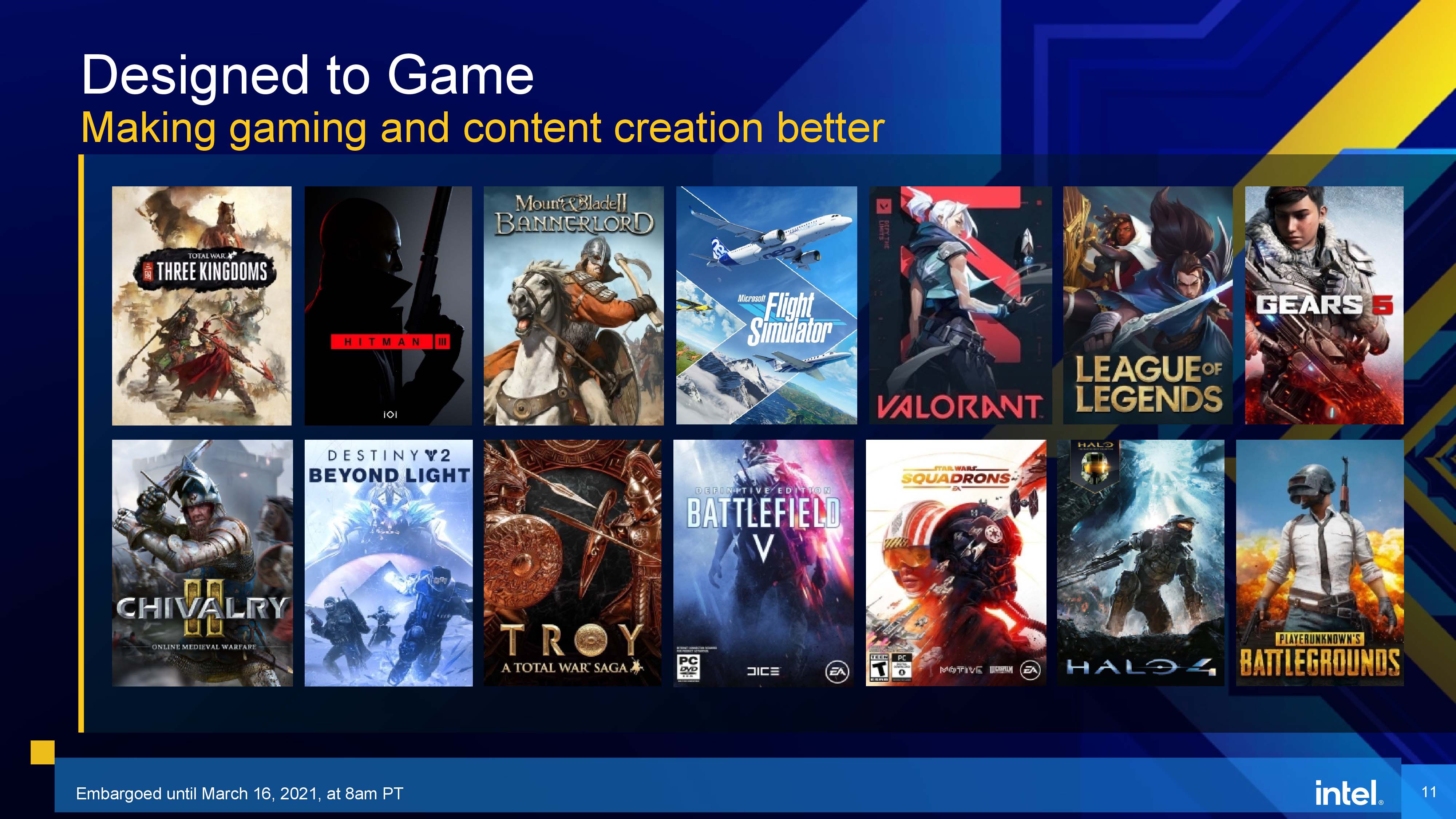
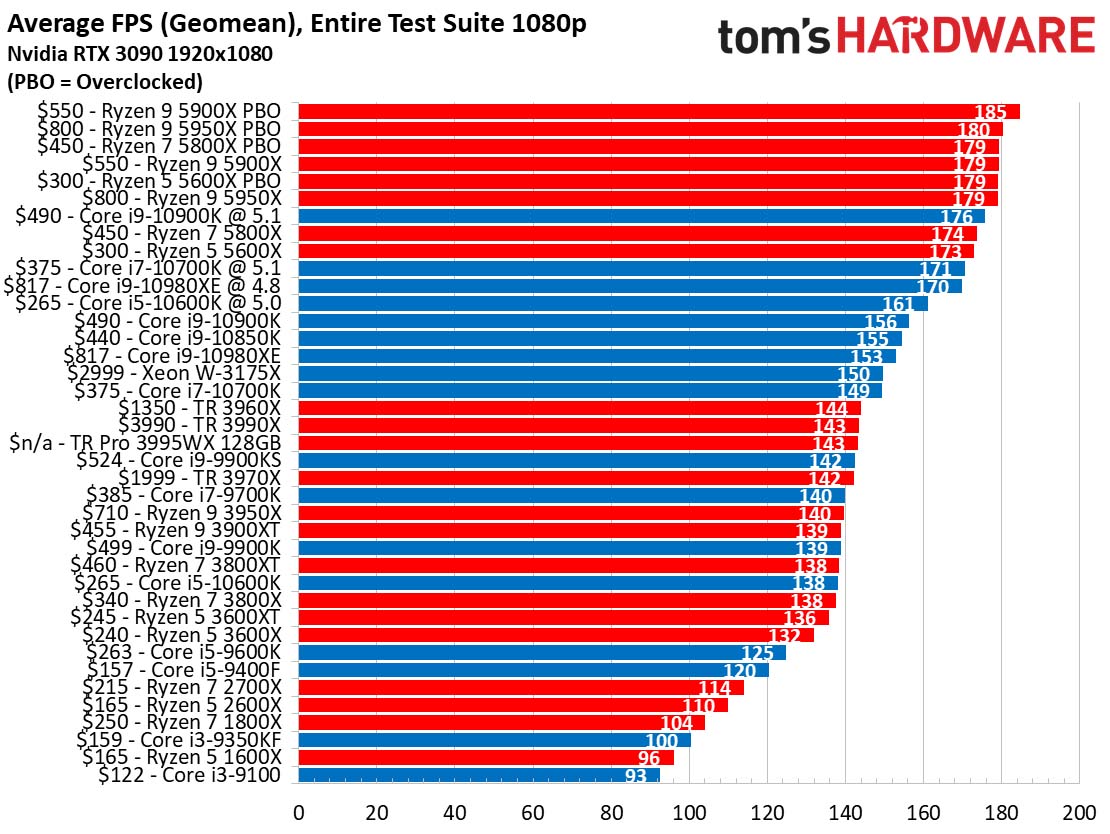
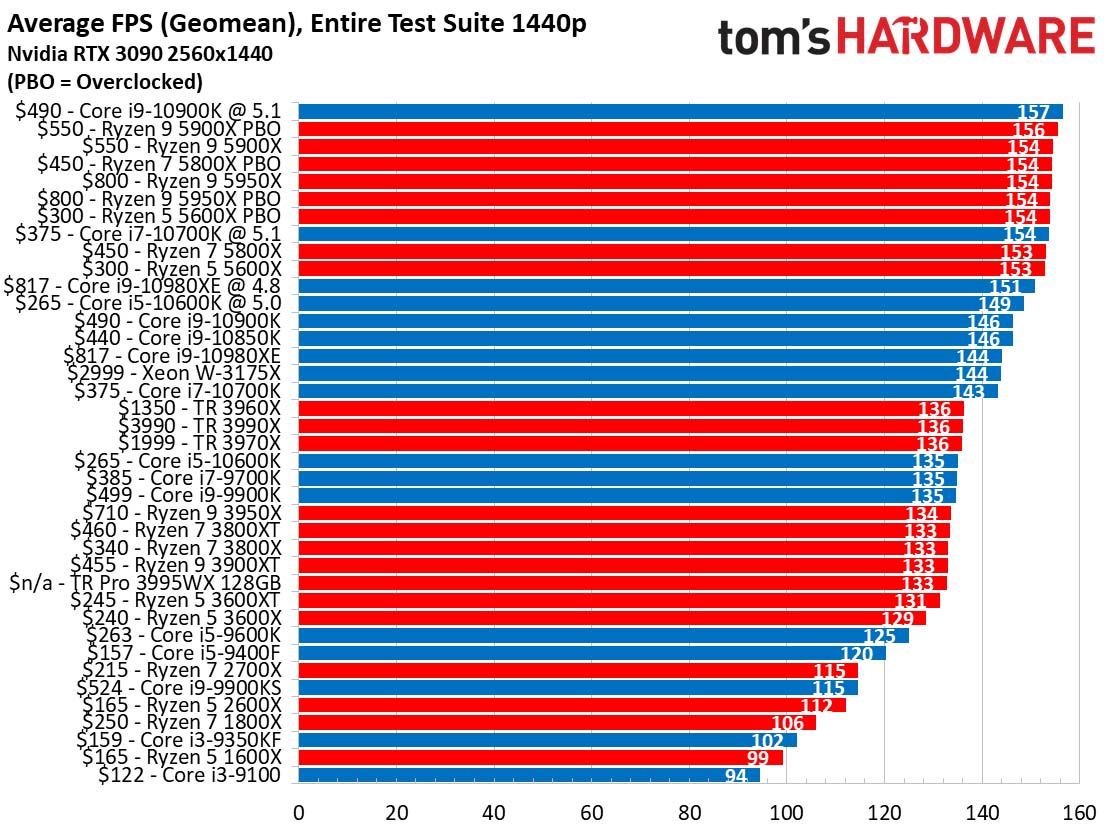
Inteal provided a full batch of new benchmarks for the official launch announcement, but these are a bit questionable. Intel listed the PL1 rating, which is the power consumption measured at base frequencies, as 250W for all Rocket Lake processors in its gaming tests. This represents a 100W increase over Intel's 150W PL1 spec (250W is the PL2 rating -power during boost), which essentially grants the processors an infinite boost (tau) duration and allows them to operate at higher levels of performance. Meanwhile, the company assigned the competing Ryzen processor at its standard 105W PL1 and the Comet Lake models to a 150W PL1, meaning we're looking at a lopsided battle. All other variables for the testing were similar between the test systems.
Intel compared the Core i9-11900K to the Ryzen 9 5900X, which currently tops our CPU benchmarks as the fastest gaming chip on the market, in a narrow selection of titles at 1080p High settings. Intel claims a 10% advantage over the Ryzen 9 5900X in the Total War Kingdoms Dynasty benchmark, 9% higher fps in Gears 5, an 8% advantage in GRID 2019, and an 11% lead in Microsoft Flight Simulator 2020.
Intel also presented gaming benchmarks showing the gen-on-gen performance gains of the Core i9-11900K against the 10900K, and the Core i5-11600K against the 10600K. As you would imagine, Intel recorded strong generational gains.
Intel's final slide plays up its strong partnerships with several game developers, through which it helps optimize their game engines for Intel processors. Bear in mind that three of the four titles used for Intel's gaming benchmarks are listed. For a perspective of the current state of gaming performance, we included a few of our own gaming benchmarks at the end of the album with the current Comet Lake and Ryzen lineups.
Intel Rocket Lake Cypress Cove Architecture
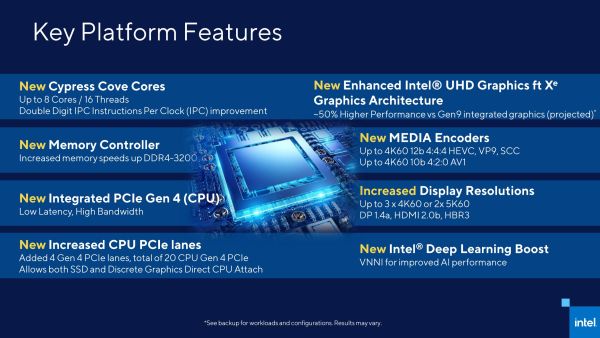

Intel finally confirmed one tidbit that wasn't entirely clear: The new chips feature the backported Cypress Cove architecture, its first new microarchitecture for the desktop PC since Skylake arrived back in 2015. Intel says this new architecture is based on Ice Lake's 'Sunny Cove' architecture and also comes with the same performant 12th-gen Intel Xe LP graphics engine found in the Tiger Lake processors.
"Back-porting" is a method that allows Intel to take a new design built on a smaller process node, in this case 10nm, and etch it on an older, larger node (in this case 14nm). The chips come with a new microarchitecture, but they still leverage Intel's 14nm process, although we don't know which revision (14nm++++?).
Rocket Lake also marks Intel's first desktop PC chips that support the PCIe 4.0 interface, a needed addition that comes two long years after AMD led the industry with the first PC chips to support the interface. Intel also reworked the internal PCIe subsystem to accommodate a x4 direct connection (the chips now support 20 lanes) for M.2 SSDs to the CPU. The chip also exposes 16 lanes to the system. Despite the fact that Intel widened the DMI bus, it still operates at speeds similar to PCIe 3.0. Additionally, the 500-series chipset only supports 24 lanes of PCIe 3.0 connectivity — not PCIe 4.0. Intel says this is because it had PCIe 4.0 IP ready for its chip, but not for the chipset.
Intel also widened the DMI 3.0 connection (the pathway that connects the CPU and chipset) from four lanes to eight, doubling throughput up to a theoretical ~7.86 GB/s. However, caveats apply when it comes to support with previous-gen motherboards, which we'll cover below. The wider DMI connection should help with bottlenecks for devices attached to the chipset, like SSDs in RAID. The chipset also now features an integrated USB 3.2 Gen 2x2 controller, doubling support over the existing interface to 20Gbps.
Intel also touted support for its Deep Learning Boost (DLBoost) and VNNI features, which require support for AVX-512 instructions. Both DLBoost and VNNI will enhance performance in workloads that leverage AI algorithms.
Enthusiasts can also look forward to new overclocking features, which would be helpful as Intel's overclocking headroom, while shrinking, still tends to be a big advantage over AMD's chips. Intel has also revamped its eXtreme Tuning Utility (XTU) with a new, fresher look and added new features to enable Rocket Lake's new overclocking options. That includes new overclocking offsets, like a separate AVX-512 offset and the ability to set voltage guardbands for the different flavors of AVX. Intel also added an option to completely disable AVX support, though that feature is primarily geared for professional overclockers.
Dan Ragland, Intel's principle overclocking engineer, says that most users can expect similar overclocked CPU frequencies to the 10th-Gen Comet Lake processors. That equates to a common ceiling of a 5.2 GHz all-core overclock (with AVX offsets applied) on most Rocket Lake chips, though the silicon lottery does apply. With more robust cooling, Ragland claims users with cherry chips can add a few more hundred megahertz to that total, albeit on a limited number of cores.
Although Rocket's overclocking ceilings are very similar to Comet Lake, the increased IPC should result in larger performance gains, comparatively. Like the Comet Lake chips, Rocket also supports per-core frequency and hyper-threading control (enable/disable) to help eke out more overclocking headroom.
Intel has also added support for real-time memory frequency adjustments, though motherboard support will vary by model and vendor. This feature allows you to shift from, say, DDR4-2933, for example, to DDR4-3200 from within Windows 10 without rebooting. Intel also continues to support its existing mechanism for live memory timing adjustments from within the operating system, giving users a plethora of on-the-fly memory overclocking options. Overall, Ragland says he thinks that Rocket Lake's memory controllers, which are entirely new, coupled with the expanded memory overclocking features, will help topple many of the existing world records.
Intel's overclocking headroom, while shrinking, still tends to be a big advantage over AMD's chips. Intel also helped develop new sub-ambient coolers from EKWB QuantumX Delta TEC and Cooler Master MasterLiquid ML360 Sub-Zero to bring extreme cooling to the masses, but these are somewhat expensive and exotic solutions for very specific uses, which you can read about here.
Intel also added new features to the graphics engine, with new HEVC, VP9, and SCC encoders that support up to 4K60 12b and hardware-accelerated AV1 support for 4K60 10b. Keep your eye on AV1; this seems to be the looming industry standard. Intel also touts the increased display resolution, with now stretches up to three screens at 4K60 or two screens at 5K60.
Intel's Rocket Lake Die Shots and Comparisons


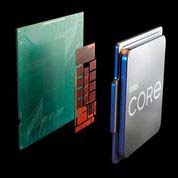
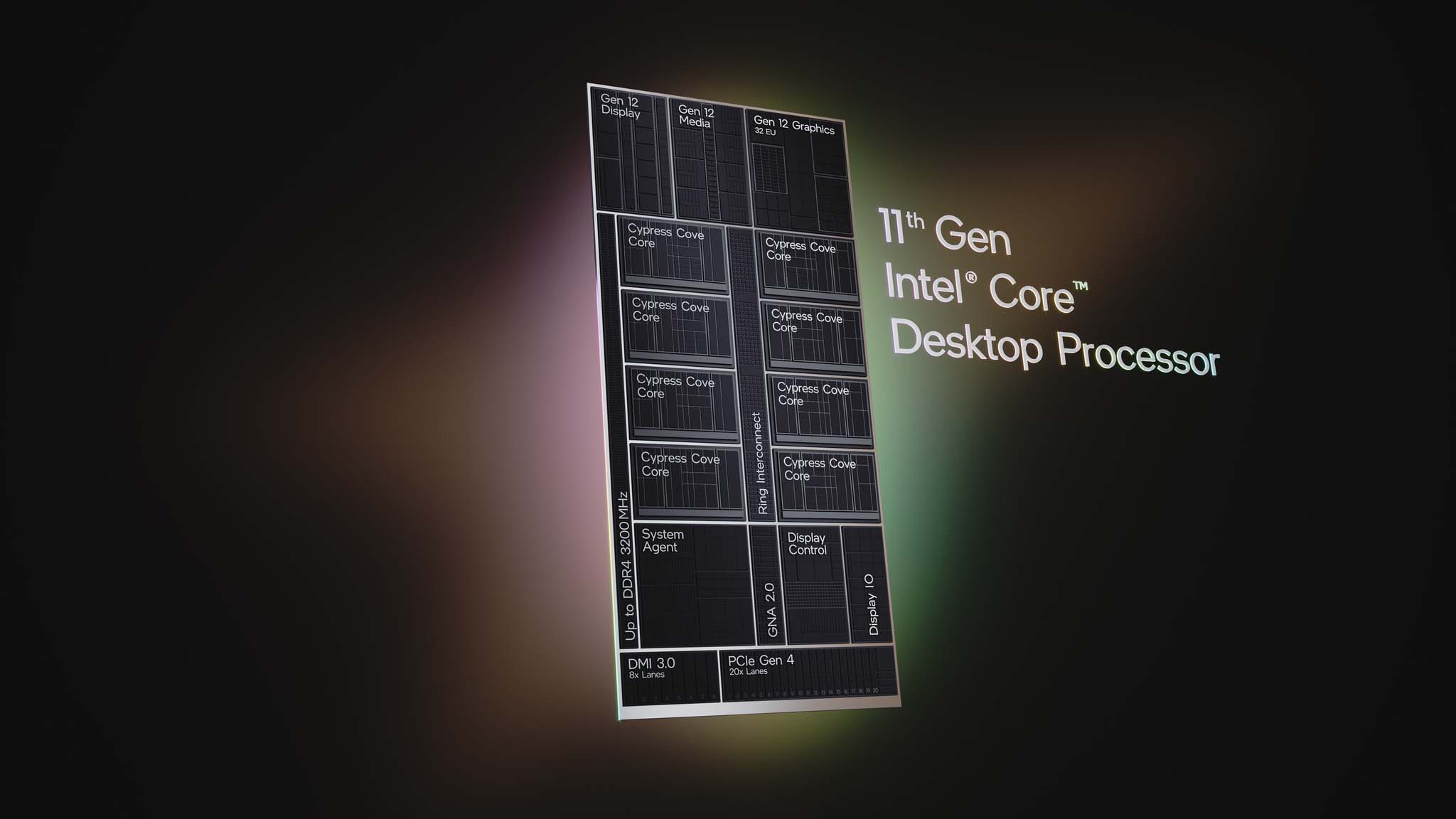
We aren't prepared to potentially sacrifice our sample by doing a risky delid yet, but luckily a daring enthusiast recently delidded a Core i7-11700K processor and shared the results at the Overlock.net forums. Unfortunately, the processor didn't live through the procedure, but we can get a good sense of the size of Rocket Lake's die through a photo lineup compiled from Der8auer's excellent die analysis article (via @harukaze5719).
Intel has confirmed that all Rocket Lake-S chips come with the same eight-core die, with two cores disabled for the six-core models. Surprisingly, based on our rough projections, Rocket Lake's eight-core die is about 34% larger than the ten-core Comet Lake die.

| Generation | Model | Cores | Die Size |
| Rocket Lake-S | Core i7-11700K | Eight | 276.4 mm2 |
| Comet Lake-S | Core i9-10900K | Ten | 206.1 mm2 |
| Coffee Lake-S Refresh | Core i9-9900K | Eight | 180.3 mm2 |
| Coffee Lake-S | Core i7-8700K | Six | 153.6 mm2 |
Intel chalks much of this disparity up to GPU and CPU cores that are physically larger than those found on Comet Lake, a byproduct of backporting from 10nm to 14nm, along with the increased number of graphics EUs. Intel could have shrunk or removed the integrated graphics engine to cram in more CPU cores to meet its power, performance, area, and cost (PPAC) targets, but integrated graphics are a key requirement for the high-volume OEM systems market that tends to leverage on-chip graphics rather than discrete GPUs.
Intel's 14nm process is ultra-mature, so we assume yields are well in line and the majority of its chipmaking equipment is depreciated. However, fabbing a larger die exposes the chips to a greater chance of defects, thus complicating the binning process, and also results in fewer die per wafer. All of these factors increase cost, which could help explain Intel's higher pricing for its highest-binned SKUs.
The company hasn't shared the Cypress Cove architecture's deep-dive details yet, but chip detective @Locuza_ shared the following Rocket Lake-S die annotation. We caution that Intel hasn't confirmed the marked units, but the arrangement aligns with our general expectations of the new design.
Intel has made significant alterations to the L2 and L3 caches – we now have a 512KB of L2 cache, a doubling over Skylake, and 16MB of L3 spread across eight 2MB slices. The L1I and L1D caches remain similar to those found on Skylake.
Even though the images aren't scaled similarly, we can also see that the Xe LP graphics cores appear to be much smaller than those found on Tiger Lake. However, that isn't entirely unexpected: The Rocket Lake chips purportedly come with up to 32 EUs, while Tiger Lake scales up to 96 EUs. We can also see that the uncore is much larger than that of the Tiger Lake-U die used for comparison, which isn't surprising given the support for 20 lanes of PCIe 4.0.
Intel 11th-Gen Core Rocket Lake Xe Graphics
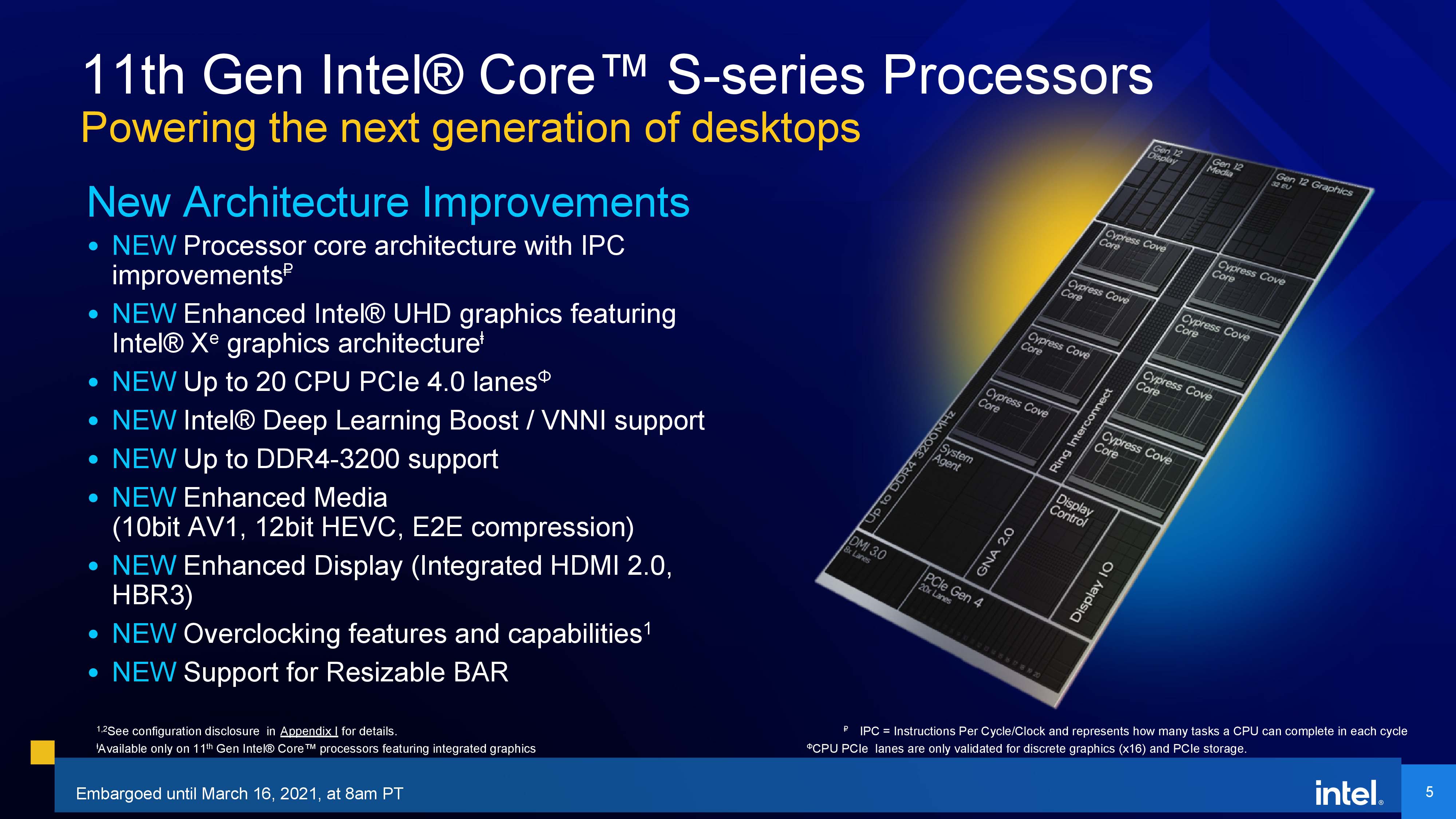

Most Rocket Lake chips come with the UHD Graphics 750 engine powered by 32 EUs with the Xe architecture. Intel has carved the Xe LP graphics engine into UHD Graphics 750 (GT1) with 32 EUs and UHD Graphics 730 (GT1) with 24 EUs. The latter makes an appearance on the Core i5-11400 (T and F) chips. Intel also added new features to the graphics engine, with HEVC, VP9, and SCC encoders that support up to 4K60 12b and hardware-accelerated AV1 encode support for 4K60 10b.
Intel dedicated more die area to the graphics engine than it did with Comet Lake, noting that not only has it increased the number of EUs from 24 to 32, but the EUs are also physically larger than prior 14nm EUs. The increased iGPU real estate was a factor in Rocket's limitation of eight CPU cores.
Intel bases its 50% generational iGPU performance improvement claim on the 3DMark Firestrike GPU benchmark, and as with all synthetic gaming tests, those results don't often translate well to real-world gaming. As such, you should take those predictions with a grain of salt.
As before, you're free to overclock the graphics engine and it also benefits from increased memory bandwidth, so memory overclocking pays dividends.
Intel 11th-Gen Rocket Lake Motherboard Support
Intel has now enabled memory overclocking on its B560 and H570 chipsets, and that will work with any chip that is compatible with the platform, meaning all 10th-Gen Comet Lake, 11th-Gen Rocket Lake, and 11th-Gen Comet Lake Refresh processors. Intel is also adding support for Resizable Bar on all 500-series chipsets, provided the discrete GPU has a driver that supports the feature. Resizeable Bar enables faster gaming performance in some game titles by allowing the CPU to access the GPUs full frame buffer across the PCIe interface.
Can you use your 400-series motherboard for Rocket Lake processors? Yes, but serious caveats apply.
The Rocket Lake-S chips are backward compatible with most 400-series chipsets. The LGA 1200 socket adheres to the same physical dimensions, and PCIe 4.0 will work on existing motherboards that support the interface. However, Rocket Lake-S isn't compatible with the H410 and B460 chipsets because they use a different 22nm chipset.
Rocket Lake's wider x8 DMI connection is only active on 'select' 500-series chipsets, so the chip defaults to a x4 connection on B560 and H510 motherboards. The same x4 connection applies for Rocket Lake processors in 400-series motherboards.
Most Comet Lake chips are forward-compatible with the new 500-series motherboards that debuted recently, the lone exception being Celeron models with 2MB of CPU cache. There are a few restrictions, though: Comet Lake chips also only use a x4 DMI connection on all 500-series motherboards.
Socket 1200 motherboards will be short-lived. According to Intel's own documentation, the hybrid Alder Lake-S processors that arrive in the latter half of 2021 will drop into Socket 1700. That means there will be no forward compatibility for Socket 1200 motherboards with future Intel processors.
We have a deeper dive into the chipset and coverage of all forty-five Z590 motherboards for Rocket Lake and Comet Lake processors here. You can also follow this link to see the differences between Intel's Z590, H570, B560, and H510 chipsets.
Given that the Rocket Lake 500-series motherboards come with the same physical LGA 1200 socket dimensions as the 400-series, existing LGA 1200 coolers should be compatible between the two series. In fact, Noctua has already begun to prepare its compatibility matrix. Thus far, the list spans over thirty Z590 and eleven B560 motherboards.
Rocket Lake is poised for liftoff soon, and we'll update this article as new details come to light.

Paul Alcorn is the Editor-in-Chief for Tom's Hardware US. He also writes news and reviews on CPUs, storage, and enterprise hardware.
-
JayNor I believe both Tiger Lake and Ice Lake Server chips doubled the ring bus bandwidth. relative to Ice Lake laptop. It will be interesting to see if that makes it into the Rocket Lake design.Reply
Also ... PCIE3 cards are supposed to work on a PCIE4 bus, by design. In fact, authors commented that PCIE3 and PCIE4 functionality were demoed on Intel's FPGA PCIE5 chiplet implementation in 2019. -
mdd1963 yayyy, more 14 nm option! :/Reply
(This next Intel gen had better have quite a few tweaks, faster RAM speeds at 3600 MHz stock, etc., to fend off the Ryzen 5800X/5900X it seems, if the first few CPU-Z and Ashes leaks are accurate..) -
shady28 PPL making comments about nanometer process tech - need to read this.Reply
https://www.techpowerup.com/272489/intel-14-nm-node-compared-to-tsmcs-7-nm-node-using-scanning-electron-microscope
"The results? Well, the Intel 14 nm chip features transistors with a gate width of 24 nm, while the AMD/TSMC 7 nm one has a gate width of 22 nm (gate height is also rather similar). "
"Another interesting thing to note here, the gate width is not following the naming scheme as you might have expected. The 14 nm transistor isn't 14 nm in width, and the 7 nm transistor isn't 7 nm wide. The naming of the node and actual size of the node have had a departure a long time ago, and the naming convention is really up to the manufacturer - it's become more of a marketing gimmick than anything else. " -
ingtar33 4 different clocked versions of their 8c/16t flagship?Reply
so my friend at intel is right again. Intel is binning the ever loving <Mod Edit> out of their chips in this release, (to the point there is no overclock headroom) in order to factory overclock them. I mean what's the point of selling a K series chip if there is nothing to overclock intel? Then selling the chips that don't measure up and overclock as high as lower clocked versions. He said the yield on the top end part was so low that it would be essentially a paper chip, available only to reviewers. He said the yield to get those high clocks were so bad that at most there might be a couple thousand ever sold to the public as intel apparently takes a major loss in selling them.
I hope reviewers mention there is no overclock for these chips, and mention the fact that the top end chip will probably never see store shelves... -
TerryLaze Reply
There are so few 5800/5900 around that they don't really need to compete, only the 5600 is decently available and for anything below that it's an AMD free market.mdd1963 said:yayyy, more 14 nm option! :/
(This next Intel gen had better have quite a few tweaks, faster RAM speeds at 3600 MHz stock, etc., to fend off the Ryzen 5800X/5900X it seems, if the first few CPU-Z and Ashes leaks are accurate..)
If they are just a little bit better than 10th gen they are going to sell them like crazy.
AMD only has three models right now, even if everybody that wants one of those three waits until they can get one it's not going to make much of a difference, everybody else that needs a different model is forced to go intel. -
Conahl ahh, there is the oh so usual positive spin on some negative towards intel, from the pro intel TerryLaze.Reply
and what happens IF rocket lake is just hype, or the power usage of these chips is worse, priced too high, then to top that off, zen 3 starts to be come more available then it currently is ?
with intels track record from is PR teams the last few years, it would be better to take anything intel says. with a good cup of salt. -
mdd1963 "not to mention that eight cores certainly feels inadequate in the face of AMD's 16-core Ryzen 9 3950X. "Reply
Much less , the 5950X...? -
TerryLaze Reply
The same thing that happens for the last three years will happen, intel will still sell everything.Conahl said:and what happens IF rocket lake is just hype, or the power usage of these chips is worse, priced too high, then to top that off, zen 3 starts to be come more available then it currently is ?
Even if intel released the same 10th gen as 11gen and only left the new iGPU they would still make all the sales, now it has that it has the new arch it has pcie4 it has better memory clocks...it will sell at least as well as 10th gen. -
Conahl maybe, but i think its time intel pulled its head out of its butt, and realized that most that buy the top 3-4 tiers of its cpus, probable wont use the IGP. use that die space for other things.Reply
